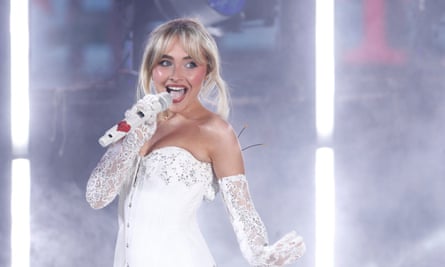Madonna, Beyoncé, Britney, Whitney: if you think about the most iconic names in mainstream pop history, you’ll probably come up with a list of women. And this week, we have solid confirmation of female artists’ dominance. British audiences listen to more female musicians than male, according to the latest industry figures for 2023.
It was the most successful performance for women on the UK singles chart since it began in 1952, the British Phonographic Institute (BPI) found. This included artists such as Raye and PinkPantheress, both of whom saw their music proliferate on TikTok this year, and those global heavy hitters you’d probably expect: Miley Cyrus – whose single Flowers stayed at No 1 for 10 weeks on the UK chart – Billie Eilish, Taylor Swift, Olivia Rodrigo et al.
And yet, despite this, unbalanced festival line-ups and award ceremonies dominated by men do little to reflect the cultural weight that woman artists carry. The music business has always been deeply sexist. It is only in very recent years that female pop artists in general have been taken seriously by the music press and listeners at large. But the latest figures do show some signs of change.
First, the figures offer confirmation and recognition that a large majority of the biggest names in mainstream music are now women. And second, they show that the commercial heft of female musicians now matches their societal impact.
Throughout the decades, women have always made the best pop stars, in my view (consider all of those I mentioned above for proof), through a unique mix of sexuality and magnetism and the fact that pop music itself has long been coded culturally as feminine. A “poptimist” shift in the last couple of decades seems to finally have decreed pop music and, perhaps, the women who make it, as worthy of genuine critical attention. Lana Del Rey, for instance – now widely considered America’s greatest living songwriter – was famously dismissed as unserious at her 2012 debut.
Also worth considering js the simple fact that there aren’t really as many male pop juggernauts as there used to be, despite the perma-popularity of artists such as Ed Sheeran, Lewis Capaldi and Harry Styles. Where we had the charisma machine that was George Michael in the 1980s and, in the 1990s and 2000s, Robbie Williams – whose historic 2003 Knebworth concerts still hold the record for the most people an artist has ever played to in Britain – there are few solo male pop artists who, today, feel as if they come close.
The pipeline of female solo artists about to come into the mainstream, too, is in rude health: the most exciting “rising” pop acts in the world now tend to be young women. The coming year, for instance, looks to be dominated by a 20-year-old Canadian named Tate McRae, whose stage presence and physical precision call to mind Britney Spears in the early 2000s. On their way to household name status, too, are Sexyy Red, Sabrina Carpenter, Reneé Rapp and a host of others.
As more and more women enter the cutthroat world of the mainstream charts, then, what I hope the music industry learns from women’s success in 2023 is that it should meaningfully recognise their contribution. It is ironic that the industry’s own repeated mistreatment of women is a topic that many of the young women declared by the BPI as some of the most listened-to artists of the past year have addressed in their music as recently as 2023.
Taylor Swift wrote about executives’ fetishisation of younger musicians on 2021’s Nothing New, and in the same year, Olivia Rodrigo sang “Who am I if not exploited?” on Brutal, the opening track of her debut album Sour, released when she was just 19 years old. Raye’s first record, My 21st Century Blues, out last February, openly addresses her firsthand experiences of abuse by men in the industry.
There are countless examples of generational stars – from Britney herself to Amy Winehouse – who have been demeaned and treated as playthings by the industry, the press and, as a result, the public. It’s a depressing thought, but perhaps stats on a page are what it takes to make a change. Now that women’s value to the industry is indisputable, it may start to be kinder to them.

